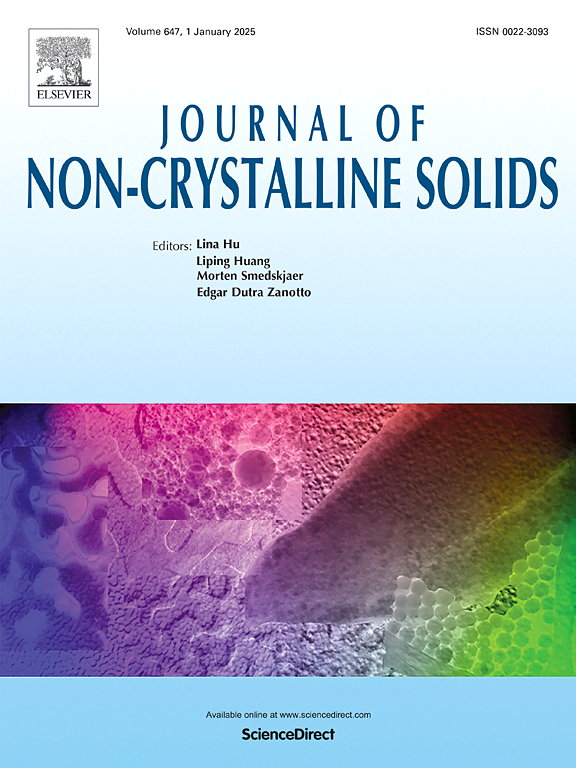Spectral analysis study on the UV photosensitive properties and mechanisms of photo-thermo-refractive glass
IF 3.2
3区 材料科学
Q1 MATERIALS SCIENCE, CERAMICS
引用次数: 0
Abstract
The cerium element co-exists in the forms of Ce4+and Ce3+in the photo-thermo-refractive (PTR) glass matrix, with the concentration of the photosensitive factor Ce3+ determining the photosensitive properties of PTR glass. This study investigates the effects of various fundamental and doping components on the Ce3+ content and photo-sensitivity of PTR glass, offering a detailed discussion on the photosensitive mechanism of PTR glass under continuous and femtosecond UV laser irradiation, as well as the dynamic transformation process of internal particles. The results reveal that an increase in Na2O content slightly decreases the Ce3+ content in PTR glass, while an increase in CeO2 content simultaneously elevates the Ce3+/Ce4+ content. Sb2O3/SnO2 doping significantly enhances the Ce3+ content in PTR glass at the constant CeO2 content. Under continuous UV laser irradiation at 325 nm, most of the Ce3+ ions converted to [Ce3+]+accompanied by absorbing photon energy and releasing electrons. An increase in irradiation dose facilitates the formation of more Ag0 atoms, while variations in irradiation power primarily augment the number of free electrons within the glass matrix. In terms of the photosensitive mechanism during irradiation with a 343 nm femtosecond laser, once the single pulse energy surpasses the nonlinear threshold of the material (>0.3 μJ), PTR glass releases free electrons through two ways: two-photon absorption by Ce3+and multiphoton absorption by the glass matrix. Meanwhile, the high temperature field generated by femtosecond laser irradiation can induce the formation of silver nanopraticles (Ag-NPs) in PTR glass directly.
光-热折变玻璃紫外光敏特性及机理的光谱分析研究
铈元素以Ce4+和Ce3+的形式共存于光热折变(PTR)玻璃基体中,光敏因子Ce3+的浓度决定了PTR玻璃的光敏性能。本研究考察了各种基本组分和掺杂组分对PTR玻璃Ce3+含量和光敏性的影响,详细探讨了PTR玻璃在连续和飞秒紫外激光照射下的光敏机理,以及内部粒子的动态转变过程。结果表明:随着Na2O含量的增加,PTR玻璃中Ce3+的含量略有降低,而CeO2含量的增加同时提高了Ce3+/Ce4+的含量。在CeO2含量不变的情况下,Sb2O3/SnO2掺杂显著提高了PTR玻璃中Ce3+的含量。在325 nm的连续紫外激光照射下,大部分Ce3+离子转化为[Ce3+]+,同时吸收光子能量并释放电子。辐照剂量的增加有利于形成更多的Ag0原子,而辐照功率的变化主要增加了玻璃基体内自由电子的数量。在343nm飞秒激光照射过程中,一旦单脉冲能量超过材料的非线性阈值(>0.3 μJ), PTR玻璃通过Ce3+的双光子吸收和玻璃基体的多光子吸收两种方式释放自由电子。同时,飞秒激光辐照产生的高温场可以直接诱导PTR玻璃中银纳米粒子(Ag-NPs)的形成。
本文章由计算机程序翻译,如有差异,请以英文原文为准。
求助全文
约1分钟内获得全文
求助全文
来源期刊

Journal of Non-crystalline Solids
工程技术-材料科学:硅酸盐
CiteScore
6.50
自引率
11.40%
发文量
576
审稿时长
35 days
期刊介绍:
The Journal of Non-Crystalline Solids publishes review articles, research papers, and Letters to the Editor on amorphous and glassy materials, including inorganic, organic, polymeric, hybrid and metallic systems. Papers on partially glassy materials, such as glass-ceramics and glass-matrix composites, and papers involving the liquid state are also included in so far as the properties of the liquid are relevant for the formation of the solid.
In all cases the papers must demonstrate both novelty and importance to the field, by way of significant advances in understanding or application of non-crystalline solids; in the case of Letters, a compelling case must also be made for expedited handling.
 求助内容:
求助内容: 应助结果提醒方式:
应助结果提醒方式:


